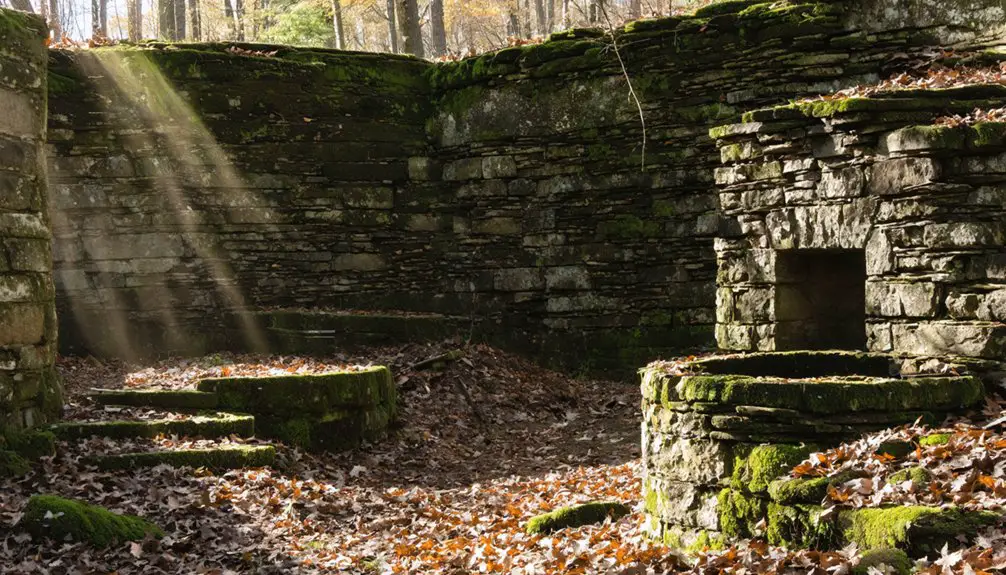You’ll find Gould Island’s abandoned naval ruins in Rhode Island’s Narragansett Bay, where a thriving military installation once tested torpedoes and housed hundreds of personnel from the 1920s to 1990s. The 56-acre island’s decaying structures include barracks, a power plant, and a firing pier with four torpedo tubes. Beyond the crumbling military remnants lies a deeper history stretching back to Native American settlements and British Revolutionary War fortifications.
Key Takeaways
- Gould Island’s abandoned military structures from the 1920s-1990s include deteriorating barracks, a power plant, and torpedo testing facilities.
- The island transitioned from Native American settlement to colonial farmland before becoming a significant military installation during World War II.
- Fort Owl’s Nest, built in 1778, housed 300 British soldiers before being abandoned in 1779, leaving historical ruins.
- The deactivated Gould Island Lighthouse, built in 1889, stands as a remnant of maritime history after its closure in 1947.
- The U.S. Navy’s departure left behind extensive military infrastructure, creating a ghost town atmosphere on this once-strategic island.
From Native Settlement to Colonial Pastures
Before Thomas Gould purchased the island in 1657, the Narragansett tribe controlled what would become known as Gould Island, maintaining it as part of their extensive territory across Rhode Island.
The tribe’s seasonal lifestyle saw them occupying winter longhouses and summer shore camps, using dugout canoes to navigate between settlements.
The Narragansett moved with the seasons, dwelling in longhouses during winter and coastal camps in summer, traveling by dugout between communities.
You’ll find that Narragansett history shifted dramatically when Gould acquired the land from Canonicus’s grandson, transforming it into colonial agriculture territory.
He primarily used the island for livestock grazing, a practice that defined its character for the next 16 years.
When Gould later split the land with John Cranston, a colonial physician and politician, it marked the beginning of broader European settlement patterns.
The island’s change reflected the expanding English presence throughout Narragansett Bay’s network of islands.
The tribe would later receive federal acknowledgment in 1983, marking a significant milestone in their ongoing struggle for recognition.
British Occupation and Revolutionary War Era
During the British occupation of Aquidneck Island that began in December 1776, you’d find Fort Owl’s Nest standing as a strategic fortification on Gould Island, controlling access to Newport Harbor.
The fort’s presence strengthened British naval dominance in Narragansett Bay while supporting Loyalist activities throughout the three-year occupation period. The harsh winter conditions caused severe soldier casualties as troops endured extreme weather at their posts. Many residents faced complex political pressures to demonstrate their loyalty during this tumultuous period.
You’ll note that Joseph Walton, a prominent Tory who purchased Gould Island in 1761, lost his property due to his British allegiance – a common fate for Loyalist landowners whose holdings were seized during the Revolutionary War.
Fort Owl’s Nest Operations
Under orders from Captain Wallace, Fort Owl’s Nest emerged as the largest British fortification in Rhode Island when it was constructed on Gould Island in 1778.
The fort’s operations centered on controlling Newport Harbor and Narragansett Bay, with extensive artillery placements overlooking key waterways. The fort notably provided cover for Patriot retreat during a crucial military operation on August 30, 1778. The fort was equipped with two mounted guns to defend against naval threats.
During its peak military operations, you’d have found:
- Barracks housing up to 300 British soldiers who maintained constant vigilance over naval movements
- Multiple gun batteries integrated with nearby defensive works like Windmill Hill Battery
- Strategic fortifications designed for both seaward and landward protection
The fort changed hands during the war, with Patriots briefly seizing control in August 1778 before British forces recaptured it.
British troops maintained their stronghold until October 1779, when they finally abandoned the position to the Patriots.
Loyalist Property Seizure
The seizure of Loyalist properties in Rhode Island marked one of the earliest and most aggressive property confiscation campaigns of the Revolutionary War, starting in October 1775.
You’ll find that local Patriot committees swiftly targeted prominent Loyalist families, including the Banister and Almy estates, using both legal mechanisms and intimidation to enforce seizures. Among those affected was Thomas Banister’s estate, which had encompassed nine valuable properties before being stripped away. Merchant George Rome became an early target after Captain Wallace’s forces protected his flour stores from angry mobs.
These confiscations weren’t just about punishment – they served multiple strategic purposes.
You’re looking at a complete reshaping of Rhode Island’s property landscape as Loyalist legacies were dismantled through property redistribution. The seized estates funded the war effort and rewarded Patriot supporters.
While British forces occupied Newport, these actions gained even more local support, as Patriots justified the seizures as necessary wartime measures against those who’d abandoned their citizenship and sided with the Crown.
In 1919, Gould Island’s transformation into a vital naval hub began when the U.S. Navy requisitioned the land to expand their torpedo station operations.
This strategic move would establish one of America’s most significant torpedo technology testing grounds, where naval strategy and innovation flourished. During peak operations, up to 100 torpedoes were tested daily to ensure maximum combat readiness. The island’s naval operations had historical roots dating back to when Captain Wallace built the Owls Nest fort in 1778.
You’ll find the island’s military presence grew dramatically during World War II, with extensive infrastructure development including:
- A seaplane base with hangars and landing ramps for torpedo-carrying aircraft
- A sophisticated firing pier featuring four torpedo tubes for underwater testing
- An advanced tracking system using hydrophones to measure torpedo accuracy
Maritime Safety: The Gould Island Lighthouse Story
Standing proudly on Gould Island’s eastern shore since 1889, a 30-foot brick lighthouse tower served as an essential navigational beacon for vessels traversing the East Passage of Narragansett Bay.
You’d find a fifth-order Fresnel lens flashing white every 10 seconds, while a fog bell helped guide ships through the bay’s notorious low-visibility conditions.
Despite the lighthouse technology’s importance, surrounding trees blocked its southern visibility. In 1932, they added an automated light on the island’s southern tip to solve this challenge. The original tower’s first keeper was Edmund Taylor, who had previously operated the private beacon.
By 1947, maritime navigation had evolved, leading to the original lighthouse’s deactivation and replacement with a skeleton tower.
Though the 1960 demolition and 1988 tower collapse erased the physical structures, the southern automated light continues its watchful duty today, carrying on Gould Island’s legacy of protecting vessels.
Harvard’s Hidden Training Ground

Before Gould Island became a military stronghold, Harvard football coach Percy D. Haughton owned much of this secluded spot, transforming it into an intensive football training ground.
You’ll find traces of this fascinating evolution from athletics to artillery, where players once practiced in isolation before the island’s $80,000 military acquisition in 1918.
Here’s what made Gould Island unique as Harvard’s training sanctuary:
- Complete isolation provided a distraction-free environment for team preparation
- Extensive private grounds allowed for specialized training routines
- Strategic location offered both privacy and accessibility from the mainland
The military shift brought dramatic changes, as football cleats gave way to torpedo testing facilities and seaplane hangars.
Today, while the Navy still maintains a presence, these historic training grounds stand as silent witnesses to both athletic glory and military innovation.
Strategic Location in Narragansett Bay
You’ll find Gould Island strategically positioned along the East Passage shipping channel of Narragansett Bay, just 1.5 nautical miles from Stillwater Basin.
The island’s central location made it an ideal military testing hub, connecting to the Naval Undersea Warfare Center’s North Test Area through underwater fiber optic systems.
Its protected deep-water access and natural harbor conditions allowed for year-round naval operations, including torpedo testing and acoustic communications research.
East Passage Shipping Channel
Located between Beavertail Point and Brenton Point, the East Passage forms the primary shipping channel in Narragansett Bay, with its 60-foot navigable depth making it the preferred route for deep-draft vessels.
You’ll find this critical waterway serving as the main artery for shipping traffic entering Rhode Island’s ports, including Newport and Quonset/Davisville.
When you’re steering through the East Passage, you’ll need to watch for:
- Complex sea states where strong currents meet ocean swells
- Navigational hazards from surrounding reefs, especially on the eastern side
- Heavy vessel congestion from commercial ships, fishing boats, and seasonal recreational traffic
The passage’s strategic position separates Jamestown and Newport routes while providing essential access to multiple islands, including Prudence and Patience Islands within the protected bay reserve system.
Military Testing Hub Position
The strategic value of Gould Island’s position in Narragansett Bay made it an ideal military testing hub during World War II.
You’ll find its coastal geography provided protected waters with direct access to open ocean, perfect for conducting live torpedo tests without interference. The bay’s depth and unique configuration created unobstructed trajectories for weapons testing while maintaining safe recovery zones.
As part of Rhode Island’s naval strategies, the island’s location proved invaluable, sitting close to Newport and Jamestown’s military infrastructure.
You can appreciate how this positioning allowed seamless integration with Coddington Cove’s research facilities and amphibious operations. The restricted access guaranteed military secrets stayed secure, while the island’s natural isolation made it perfect for conducting classified weapons testing throughout the war years.
Protected Deep Water Access
Deep within Narragansett Bay‘s protected waters, Gould’s strategic position benefits from remarkable depth variations ranging from 1.2 to 59 meters at mean low water.
You’ll find extensive deep water access throughout the bay’s channels, supported by improved water clarity and stable sediment conditions. The bay’s natural shelter protects vessels from harsh ocean conditions while maintaining multiple entry points for maritime traffic.
Key advantages of Gould’s protected deep water access include:
- Over 165,000 depth soundings confirm navigable channels for deep-draft vessels
- 75% reduction in suspended solids since the 1970s enhances underwater visibility
- Coarse sediment beds in deep channels provide reliable anchorage stability
These features combine to create ideal conditions for both commercial and recreational maritime activities, connecting Gould to crucial New England waterways.
Abandoned Military Legacy and Modern Ruins
Scattered across Gould Island’s landscape, decaying military ruins tell the story of a once-bustling naval installation that thrived from the 1920s through the 1990s.
You’ll find remnants of barracks, a power plant, and a distinctive firing pier with four torpedo tubes where cutting-edge underwater weapons were tested.
The abandoned structures stand as silent witnesses to the island’s military heritage, including the pioneering work of Navy seaplanes and torpedo development.
Frequently Asked Questions
Are There Any Known Paranormal Activities Reported on Gould Island?
While you’ll find rumors of ghost sightings around abandoned military structures, there’s no verified paranormal activity on Gould Island. Local tales mention haunted locations, but they lack documented evidence.
What Wildlife Species Currently Inhabit the Abandoned Island?
Like Noah’s menagerie, you’ll find diverse wildlife thriving here: waterbirds protected by SWAP, coastal fish species, migratory birds, small mammals, reptiles, and insects inhabiting the island’s undisturbed ecosystems.
Has Anyone Attempted to Purchase Gould Island in Recent Years?
You won’t find any recent Gould Island purchase attempts since it’s split between Navy ownership and wildlife sanctuary status. Military restrictions and access limitations have effectively prevented private acquisition opportunities.
Were Any Secret Military Experiments Conducted Besides Torpedo Testing?
Based on available military history records, you won’t find evidence of secret experiments beyond torpedo and underwater weapons testing. Though the island’s restricted nature fueled speculation, documented experimental technology focused solely on naval ordnance.
Do Any Descendants of Original Native American Owners Still Claim Rights?
You won’t find any active descendant claims or tribal rights assertions for Gould Island today. While the Narragansett tribe remains federally recognized, there’s no record of current ownership disputes from descendants.
References
- https://cranstononline.com/stories/gould-islands-history-of-tories-and-torpedeos
- https://www.youtube.com/watch?v=VbYSTtVbsBA
- https://www.youtube.com/watch?v=K5Tm2LGxBCM
- http://www.newenglandlighthouses.net/gould-island-light-history.html
- https://www.youtube.com/watch?v=MmKyEc9aHJ0
- https://www.northkingstownri.gov/999/People
- https://preservation.ri.gov/sites/g/files/xkgbur406/files/pdfs_zips_downloads/survey_pdfs/jamestown.pdf
- https://en.wikipedia.org/wiki/King_Philip’s_War
- https://battleofrhodeisland.org/the-battle-of-rhode-island-life-on-aquidneck/
- https://newporthistory.org/history-bytes-politicizing-the-personal-in-revolutionary-newport/



